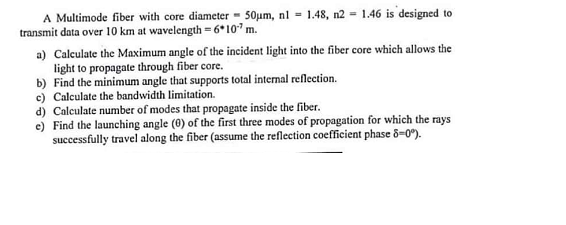A Multimode fiber with core diameter - 50µm, nl - 1.48, n2 = 1.46 is designed to transmit data over 10 km at wavelength =6*10*m. a) Calculate the Maximum angle of the incident light into the fiber core which allows the: light to propagate through fiber core. b) Find the minimum angle that supports total internal reflection. c) Calculate the bandwidth limitation. d) Calculate number of modes that propagate inside the fiber. e) Find the launching angle (0) of the first three modes of propagation for which the rays successfully travel along the fiber (assume the reflection coefficient phase 8=0").
A Multimode fiber with core diameter - 50µm, nl - 1.48, n2 = 1.46 is designed to transmit data over 10 km at wavelength =6*10*m. a) Calculate the Maximum angle of the incident light into the fiber core which allows the: light to propagate through fiber core. b) Find the minimum angle that supports total internal reflection. c) Calculate the bandwidth limitation. d) Calculate number of modes that propagate inside the fiber. e) Find the launching angle (0) of the first three modes of propagation for which the rays successfully travel along the fiber (assume the reflection coefficient phase 8=0").
Introductory Circuit Analysis (13th Edition)
13th Edition
ISBN:9780133923605
Author:Robert L. Boylestad
Publisher:Robert L. Boylestad
Chapter1: Introduction
Section: Chapter Questions
Problem 1P: Visit your local library (at school or home) and describe the extent to which it provides literature...
Related questions
Question

Transcribed Image Text:A Multimode fiber with core diameter - 50um, nl = 1.48, n2 = 1.46 is designed to
transmit data over 10 km at wavelength = 6*10" m.
a) Calculate the Maximum angle of the incident light into the fiber core which allows the
light to propagate through fiber core.
b) Find the minimum angle that supports total internal reflection.
c) Calculate the bandwidth limitation.
d) Calculate number of modes that propagate inside the fiber.
c) Find the launching angle (0) of the first three modes of propagation for which the rays
successfully travel along the fiber (assume the reflection coefficient phase 8-0").
Expert Solution
This question has been solved!
Explore an expertly crafted, step-by-step solution for a thorough understanding of key concepts.
Step by step
Solved in 2 steps

Knowledge Booster
Learn more about
Need a deep-dive on the concept behind this application? Look no further. Learn more about this topic, electrical-engineering and related others by exploring similar questions and additional content below.Recommended textbooks for you

Introductory Circuit Analysis (13th Edition)
Electrical Engineering
ISBN:
9780133923605
Author:
Robert L. Boylestad
Publisher:
PEARSON

Delmar's Standard Textbook Of Electricity
Electrical Engineering
ISBN:
9781337900348
Author:
Stephen L. Herman
Publisher:
Cengage Learning

Programmable Logic Controllers
Electrical Engineering
ISBN:
9780073373843
Author:
Frank D. Petruzella
Publisher:
McGraw-Hill Education

Introductory Circuit Analysis (13th Edition)
Electrical Engineering
ISBN:
9780133923605
Author:
Robert L. Boylestad
Publisher:
PEARSON

Delmar's Standard Textbook Of Electricity
Electrical Engineering
ISBN:
9781337900348
Author:
Stephen L. Herman
Publisher:
Cengage Learning

Programmable Logic Controllers
Electrical Engineering
ISBN:
9780073373843
Author:
Frank D. Petruzella
Publisher:
McGraw-Hill Education

Fundamentals of Electric Circuits
Electrical Engineering
ISBN:
9780078028229
Author:
Charles K Alexander, Matthew Sadiku
Publisher:
McGraw-Hill Education

Electric Circuits. (11th Edition)
Electrical Engineering
ISBN:
9780134746968
Author:
James W. Nilsson, Susan Riedel
Publisher:
PEARSON

Engineering Electromagnetics
Electrical Engineering
ISBN:
9780078028151
Author:
Hayt, William H. (william Hart), Jr, BUCK, John A.
Publisher:
Mcgraw-hill Education,